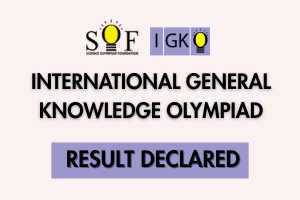
Now that the Science Olympiad Foundation (SOF) is all set to conduct Level-2 exams for IMO, NSO, and IEO on 9th Feb 2025, it’s essential that you gear up for the upcoming exams and learn all the key concepts and formulas. In this blog, we are going to talk about key formulas and concepts that students must remember or IMO and NSO. So, let’s get started with IMO first, and then we move further toward NSO.
Key Formulas and Concepts for IMO Level 2
- Prime Numbers: A prime number is a number greater than 1 that has no divisors other than 1 and itself (e.g., 2, 3, 5, 7, 11).
- Even and Odd Numbers:
Even numbers: Divisible by 2 (e.g., 2, 4, 6, 8).
Odd numbers: Not divisible by 2 (e.g., 1, 3, 5, 7).
- Divisibility Rules:
Divisible by 2: Last digit is even.
Divisible by 3: Sum of digits is divisible by 3.
Divisible by 5: Last digit is 0 or 5.
Divisible by 10: Last digit is 0.
- GCD (Greatest Common Divisor)
Use Euclidean Algorithm: GCD(a,b) = GCD(b,a mod b). - LCM (Least Common Multiple)
LCM(a,b) = LCM (a,b) = (a x b)/GCD(a,b)
- Addition and Subtraction: Understanding properties like commutativity and associativity:
Commutative Property: a + b = b + a
Associative Property: (a + b) + c = a + (b + c) - Multiplication:
Multiplying by 10, 100, etc.: Multiply the number and add zeroes accordingly.
Multiplication properties:
Commutative: a × b = b × a
Distributive: a × (b + c) = a × b + a × c - Division: Long division for dividing large numbers.
- Fractions:
Fraction representation: , where a is the numerator and b is the denominator.
Simplifying fractions: Divide numerator and denominator by their GCD.
Equivalent fractions:
Addition/Subtraction of fractions: Same denominator.
- Decimals:
Converting fractions to decimals and vice versa.
Adding and subtracting decimals.
- 2D Shapes:
Perimeter and Area of simple shapes:
Rectangle: Perimeter = 2 × (l + b); Area = l × b
Square: Perimeter = 4 × a, Area = a2
Circle: Circumference = , Area = πr2 - Angles:
Right angle: 90°
Acute angle: Less than 90°
Obtuse angle: Greater than 90° - Symmetry:
Identifying lines of symmetry in shapes like squares, circles, and triangles.
- Arithmetic Sequences: A sequence in which the difference between consecutive terms is constant (e.g., 2, 4, 6, 8, 10…).
Formula for nth term: , where a is the first term and d is the common difference.
- Geometric Sequences: A sequence where each term is multiplied by the same number (e.g., 3, 6, 12, 24…).
Formula for nth term:, where a is the first term and r is the common ratio.
- Modeling Word Problems: Translating word problems into mathematical expressions.
Example: “If there are 5 bags with 6 apples in each, how many apples in total?” (Multiplication: 5 × 6 = 30).
- Length: Conversion between units (cm, m, km).
1 m = 100 cm, 1 km = 1000 m
- Weight: Conversion between units (g, kg).
1 kg = 1000 g
- Time: Conversion between units (seconds, minutes, hours).
1 hr = 60 minutes, 1 minute = 60 seconds, 1 hr = 3600 seconds
- Volume: Understanding the units for volume (liters, milliliters).
1 ltr = 1000 ml
- Understanding simple probability as the likelihood of an event happening.
Probability formula: P(A) = Number of favorable outcomes / Total number of possible outcomes
- Mean: Average of a set of numbers:Mean = Sum of numbers / Number of items
- Median: The middle value when numbers are arranged in order.
- Mode: The most frequent number in a set of data.
- Clock: Time in hours, minutes, and seconds, including both analog and digital.
- Calendar: Calculating the number of days between two dates, leap years.
- Area of triangle: Area = 1/2 x Base x Height
- Volume of Rectangular prism: Volume = Length x Width x Height
- Pythagoras theorem: For right angled triangle: a² + b² + c² (where c is the hypotenuse).
- Proportions Shortcut: a/b = c/d ⇒ ad = bc
- Percentage calculation: percentage = part/whole x 100
- Percentage increase/Decrease: New value =Orignal value x (1+percentagechange/100)
- Speed Formula: Speed = Distance/time
- Time Formula: Time = Distance/speed
- Distance Formula: Distance = Speed x Time
By using these shortcuts and formulas, you can efficiently tackle IMO and improve your problem-solving skills!
Recent – Top 10 Tips to Tackle MCQs in SOF Level-2 Olympiad Exams!
Key Formulas and Concepts to Remember for NSO Level 2
Now, let’s discuss key formulas and concepts for NSO.
- work done (W = F ⋅ d ⋅ cos θ)
- kinetic energy (KE = ½mv²)
- potential energy (PE = mgh)
- conservation of energy
- Momentum (p = mv)
- Impulse-momentum theorem (FΔt = Δp)
- Conservation of momentum
- Torque (T = rF sin θ)
- Angular momentum (L = Iω)
- Moment of inertia
- Rotational kinetic energy
- Coulomb’s Law (F = k q1q2/ r2)
- Electric field (E = F/q)
- Electric potential (V = k q/r)
- Ohm’s Law (V = IR)
- Power (P = IV)
- Kirchhoff’s Laws
- Biot-Savart Law, Ampere’s Law
- Lorentz Force (F = q(v × B))
- Electromagnetic Induction (Faraday’s Law, Lenz’s Law)
- Protons, neutrons, electrons
- Atomic number, mass number, isotopes
- Electron configuration, orbitals, quantum numbers
- Trends: atomic radius, ionization energy, electronegativity, electron affinity
- Groups (alkali metals, halogens, noble gases) and periods
- Types: synthesis, decomposition, single replacement, double replacement, combustion
- Redox reactions, oxidation states
- Endothermic vs. exothermic reactions
- Heat, work, enthalpy, entropy, Gibbs free energy
- Calorimetry, Hess’s law
- Structural isomers, stereoisomers (geometric, optical)
- Chirality, enantiomers, diastereomers
- IUPAC naming rules
- Prefixes, suffixes for functional groups
Prokaryotic vs. Eukaryotic cells: Key differences (size, organelles, genetic material organization)
Cell organelles: Structure and function of nucleus, mitochondria, chloroplasts, ER, Golgi apparatus, lysosomes, peroxisomes
Cell membranes and transport: Fluid mosaic model; passive and active transport mechanisms; endocytosis and exocytosis
Basic principles: Dominant/recessive alleles, segregation, independent assortment
Extensions: Incomplete dominance, codominance, multiple alleles, epistasis, polygenic inheritance
Pedigree analysis: Autosomal dominant/recessive traits, X-linked traits
Human organ systems: Structure and function of the circulatory, respiratory, digestive, nervous, endocrine, excretory, and reproductive systems
Homeostasis and regulation: Negative and positive feedback mechanisms, osmoregulation, thermoregulation
Neurobiology: Neuron structure, nerve impulse transmission (action potentials, synapses), reflex arcs
Muscle physiology: Types of muscle tissue (skeletal, smooth, cardiac), muscle contraction (sliding filament model)
Conclusion
By applying these concepts, shortcuts and formulas on the Level-2 practice questions offered by MTG’s PYPs and mock tests, you can efficiently tackle both IMO and NSO and improve your problem-solving skills!
































Most useful